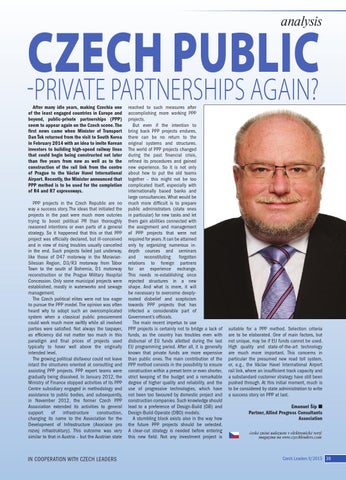analysis
Czech public -private partnerships again? After many idle years, making Czechia one of the least engaged countries in Europe and beyond, public-private partnerships (PPP) seem to appear again on the Czech scene. The first news came when Minister of Transport Dan Ťok returned from the visit to South Korea in February 2014 with an idea to invite Korean investors to building high-speed railway lines that could begin being constructed not later than five years from now as well as to the construction of the rail link from the centre of Prague to the Václav Havel International Airport. Recently, the Minister announced that PPP method is to be used for the completion of R4 and R7 expressways.
PPP projects in the Czech Republic are no way a success story. The ideas that initiated the projects in the past were much more outcries trying to boost political PR than thoroughly reasoned intentions or even parts of a general strategy. So it happened that this or that PPP project was officially declared, but ill-conceived and in view of rising troubles usually cancelled in the end. Such projects failed just underway, like those of D47 motorway in the MoravianSilesian Region, D3/R3 motorway from Tábor Town to the south of Bohemia, D1 motorway reconstruction or the Prague Military Hospital Concession. Only some municipal projects were established, mostly in waterworks and sewage management. The Czech political elites were not too eager to pursue the PPP model. The opinion was often heard why to adopt such an overcomplicated system when a classical public procurement could work much more swiftly while all involved parties were satisfied. Not always the taxpayer, as efficiency did not matter too much in this paradigm and final prices of projects used typically to hover well above the originally intended level. The growing political disfavour could not leave intact the structures oriented at consulting and assisting PPP projects. PPP expert teams were gradually being dissolved. In January 2012, the Ministry of Finance stopped activities of its PPP Centre subsidiary engaged in methodology and assistance to public bodies, and subsequently, in November 2012, the former Czech PPP Association extended its activities to general support of infrastructure construction, changing its name to the Association for the Development of Infrastructure (Asociace pro rozvoj infrastruktury). This outcome was very similar to that in Austria – but the Austrian state
IN COOPERATION WITH Czech LEADERS
reached to such measures after accomplishing more working PPP projects. But even if the intention to bring back PPP projects endures, there can be no return to the original systems and structures. The world of PPP projects changed during the past financial crisis, refined its procedures and gained new experience. So it is not only about how to put the old teams together – this might not be too complicated itself, especially with internationally based banks and large consultancies. What would be much more difficult is to prepare public administrators (state ones in particular) for new tasks and let them gain abilities connected with the assignment and management of PPP projects that were not required for years. It can be attained only by organizing numerous indepth courses and seminars and reconstituting forgotten relations to foreign partners for an experience exchange. This needs re-establishing once rejected structures in a new shape. And what is more, it will be necessary to overcome deeplyrooted disbelief and scepticism towards PPP projects that has infected a considerable part of Government’s officials. The main recent impetus to use PPP projects is certainly not to bridge a lack of funds, as the country has troubles even with disbursal of EU funds allotted during the last EU programming period. After all, it is generally known that private funds are more expensive than public ones. The main contribution of the PPP method consists in the possibility to ensure construction within a preset term or even shorter, strict keeping of the budget and a remarkable degree of higher quality and reliability, and the use of progressive technologies, which have not been too favoured by domestic project and construction companies. Such knowledge should lead to a preference of Design-Build (DB) and Design-Build-Operate (DBO) models. A stumbling block exists also in the way how the future PPP projects should be selected. A clear-cut strategy is needed before entering this new field. Not any investment project is
suitable for a PPP method. Selection criteria are to be elaborated. One of main factors, but not unique, may be if EU funds cannot be used. High quality and state-of-the-art technology are much more important. This concerns in particular the presumed new road toll system, or, e.g., the Václav Havel International Airport rail link, where an insufficient track capacity and a substandard customer strategy have still been pushed through. At this initial moment, much is to be considered by state administration to write a success story on PPP at last. Emanuel Šíp ■ Partner, Allied Progress Consultants Association české znění naleznete v elektronické verzi magazínu na www.czechleaders.com
Czech Leaders II/2015 39
